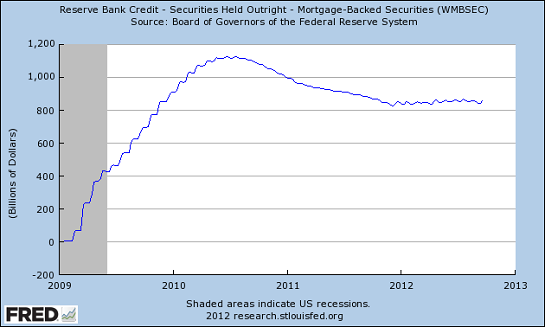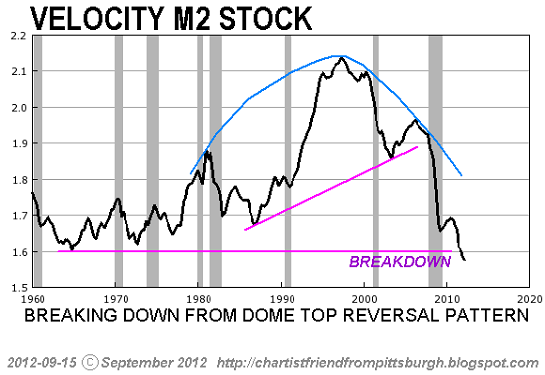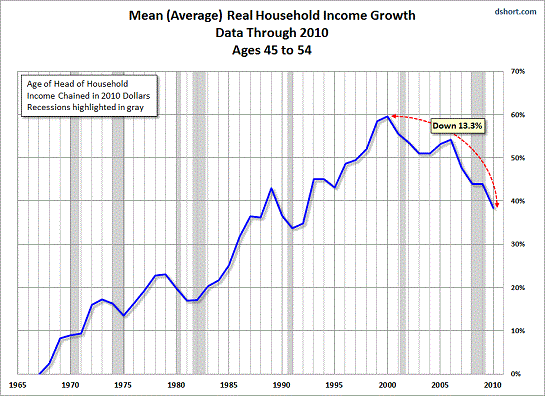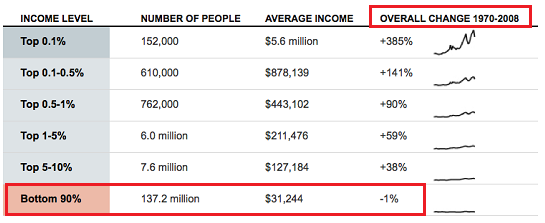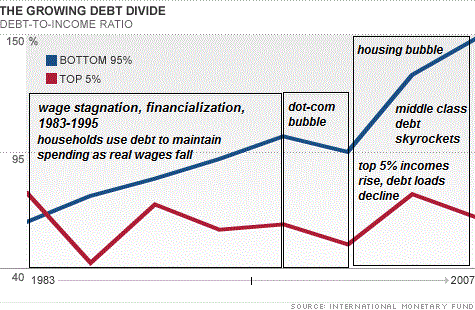"Beautiful deleveraging" is the policy goal, but what we might get is "ugly inflation."
In a world of rising sovereign debts and an overleveraged, over-indebted private sector, history suggests there are only three possible ways out: gradual deleveraging, defaulting on the debt, or printing enough money to inflate away the debt.
Ray Dalio recently described the characteristics of a “beautiful deleveraging” in which equal doses of austerity, write-downs, and inflation gradually lighten the load of impaired debt. This might be called the Goldilocks Deleveraging, as the key feature of this “beautiful” solution is that each component is “not too hot, not too cold” – inflation is modest, write-downs of bad debt are gradual, and austerity is not too severe. Given enough time, the leverage and debt are worked off without requiring any structural change to the Status Quo.
Understandably, the Status Quo has embraced this solution for the appealing reason it doesn’t change the power structure at all. Everyone currently in charge remains in charge, and everyone who owns outsized wealth continues owning outsized wealth. Rather than falling onto the politically powerful “too big to fail” banking sector, the pain of deleveraging is spread over the entire economy. There is no such thing as painless deleveraging, so the “solution” is to distribute the pain over hundreds of millions of people. That’s what makes it “beautiful” to the Status Quo: It doesn’t cost them either their power or their wealth.
The Status Quo in Japan has pursued this strategy for 20 years, and the Status Quo in Europe and the U.S. have pursued it for the past four years, ever since the global financial system imploded in 2008.
Unsurprisingly, the conventional view is that it’s working "beautifully". Housing has bottomed, stocks have doubled since their March 2009 lows, households are slowly deleveraging, inflation is modest, and growth is sluggish but steady. All we need to do, we’re told, is stay the course for a few more years, and the stage will be set for a return to the rapid growth of the bubble years.
Central Banks to the Rescue
The core mechanism of this “leave the Status Quo intact” solution is that central banks conjure money out of thin air (i.e., “print money”), which they use to then buy impaired bank debt (such as delinquent mortgages) and sovereign debt (such as the bonds of Spain, Italy and the U.S.)
This transfers impaired private-sector debt and sovereign debt to the central banks’ balance sheets, where they are safely sequestered from price discovery. The central banks keep these questionable assets on the books at full value, and the Status Quo is happy. The banks trade their risky impaired assets to the central bank for cash, which they can use to speculate or originate new loans, and governments can continue to run monumental deficits because the bonds they issue are purchased (i.e., “monetized”) by central banks.
Central bank balance sheets swell with phantom assets, but nobody cares, as the debt no longer burdens private banks and governments are free to borrow and spend.
It all seems too good to be true, and so skeptics ask: If this deleveraging is so 'beautiful', why are the developed economies sliding into recession? If this deleveraging has worked so well, why are governments still running unprecedented deficits even as hiring, production, and lending all weaken?
Skeptics of the official “happy story” see plentiful evidence that the beautiful deleveraging of central-bank monetization is simply papering over the structural rot at the heart of the financial/political Status Quo – the shadow banking system, the risk-laden derivatives trade, the “fraud-is-our-business-model” mortgage securitization industry, and so on.
Somebody Has to Pay the Price
Skeptics reviewing history find few examples of painless deleveraging and many examples where over-indebtedness and central bank money-printing lead to a stark choice: Either accept high inflation as a way of inflating debts away, or renounce sovereign debt and devalue the currency.
Neither “solution” is ideal nor beautiful. Inflating away debt by depreciating the currency (via money-printing) allows debtors to pay debt with “cheaper” money, but inflation savagely erodes financial wealth. If we earn $100,000 an hour, our $100,000 mortgage can be paid off with one hour’s labor, but our $100,000 in savings will only buy three gallons of gasoline – the same number of gallons an hour’s labor bought back when we earned $12 an hour. We can print money but not oil.
If a nation renounces its debt, everyone who owns the sovereign bonds loses some or all of their investment, and the currency loses value as global traders and investors recalibrate the value of the currency. Once the currency is devalued, imports such as oil rise steeply in cost, leaving less household income to be spent or invested. Consumers pay the price of devaluation.
In other words, there is no painless deleveraging. The price has to be paid by someone, and so the battle behind the façade of “beautiful deleveraging” is over whom the cost will be transferred to.
If the government absorbs all the banks’ bad debts and runs large structural deficits, the cost is transferred to the taxpayers. If the central bank prints money in excess in order to absorb the banks’ bad debts, inflation rears its head, and everyone with savings and who earns wages pays the price via a loss of purchasing power.
Though it is dismissed as “impossible” – and it is politically impossible, as the banks have captured the machinery of governance – banks could be forced into insolvency and their assets liquidated on the open market. This would clear the decks of impaired debt and distribute the losses to those who owned the impaired debt: pension funds, insurance companies, hedge funds, individuals, etc. Every owner would share equitably and proportionately in the losses.
But this would upset the Status Quo’s power and wealth-sharing arrangement, and so it is dismissed as unworkable.
Beautiful and Ugly Inflation
A key mechanism in beautiful deleveraging is beautiful inflation at an annual rate of, say, 3% (gosh, isn’t that the Federal Reserve’s target?) that steals 3% from the purchasing power of the currency while depreciating debts by the same 3%.
In a decade, both the value of the debt and the currency have fallen by over 30%, but the loss of purchasing power has been so gradual that the losers – wage earners, consumers, savers, and owners of the devalued debt – don’t feel enough pain to protest.
Truly beautiful inflation combines low-interest fixed-rate debt, wage and price inflation, and a stable currency. If wages and prices are both inflating at 10% a year, wage earners don’t feel any pain as their income rises in tandem with the cost of goods and services. Any mismatch – say wages rise 8% a year while prices rise 10% – is slight enough that the erosion won’t trigger any political fallout. With a stable currency, imports don’t cost more, either.
Meanwhile, low-interest fixed-rate debt is being wiped out at a rapid clip. In a decade of 10% annual inflation, the debt has lost roughly two-thirds of its value. Wages have doubled at the end of ten years, while existing mortgage payments have remained unchanged.
Debtors have an easier time servicing debt, and inflation has magically deleveraged the household. As the value of people's old debt declines and their nominal income rises, they can afford to take on more debt.
Banks can issue new debt to the newly deleveraged households, earning fat transaction fees and securitizing the newly issued debt so that it can be offloaded to investors.
The government also benefits, as rising nominal wages push taxpayers into higher income brackets, swelling government revenues. Everybody wins. Households get to consume more goods and services, banks get to originate more debt, and the government rakes in more tax revenues. No wonder the Status Quo is pursuing beautiful inflation.
Two things can turn beautiful inflation into ugly inflation: Wages don’t inflate along with prices and the currency depreciates as money is printed excessively. This might not matter for a nation that is a net exporter of goods and services. But for nations that import essentials such as oil and grain, this is a catastrophe, as wages are flat while the cost of imported energy and food skyrocket. Households have less money to spend, and servicing debt becomes increasingly burdensome.
This is ugly inflation: Household incomes decline in real terms, the rising cost of essentials squeezes discretionary spending, and servicing debt becomes more difficult. Households not only cannot afford new debt; many have to default on debt just to survive. Bank lending falters and defaults rise, eroding banks’ solvency. As household incomes stagnate, government tax revenues decline as well.
In ugly inflation, everybody loses.
Welcome to the United States of Ugly Inflation. Real household income (i.e., adjusted for official inflation) has declined 8% since 2007; the cost of oil, medical care and higher education has climbed; and government revenues have stagnated even as demand for government services has increased.
As a result, the entire beautiful deleveraging scenario is at risk. Austerity carries a high political cost, and central bank printing appears to be fueling ugly inflation. Behind the “happy story” façade, falling incomes mean that household deleveraging is an illusion, along with bank solvency.
What else is at work here? Where is this leading? Possibly to destinations many reading this may not expect.
In
Part II: Why the U.S. Dollar, Counterintuitively, May Strengthen from Here, we explore several key (and under-appreciated) mechanisms
. Reality rarely unfolds in a tidy linear progression (if A > than B > than C) and usually involves more factors than we think to put into our forecasting models. There are several key market influences (e.g., the price of oil) and non-market influences (e.g., sovereign interests) capable of constraining central banks' ability to print money. And as a result, the currency devaluation that many see as being baked into the cake may not materialize.
 Resistance, Revolution, Liberation: A Model for Positive Change (print $25)
Resistance, Revolution, Liberation: A Model for Positive Change (print $25)
(Kindle eBook $9.95)
We are like passengers on the Titanic ten minutes after its fatal encounter with the iceberg: though our financial system seems unsinkable, its reliance on debt and financialization has already doomed it.We cannot know when the Central State and financial system will destabilize, we only know they will destabilize. We cannot know which of the State’s fast-rising debts and obligations will be renounced; we only know they will be renounced in one fashion or another.
The process of the unsustainable collapsing and a new, more sustainable model emerging is called revolution.Rather than being powerless, we hold the fundamental building blocks of power. We need neither permission nor political change to liberate ourselves. A powerless individual becomes powerful when he renounces the lies and complicity that enable the doomed Status Quo’s dominance.
| Thank you, Harry R. ($25), for your splendidly generous contribution to this site--I am greatly honored by your continuing support and readership. |
Read more...
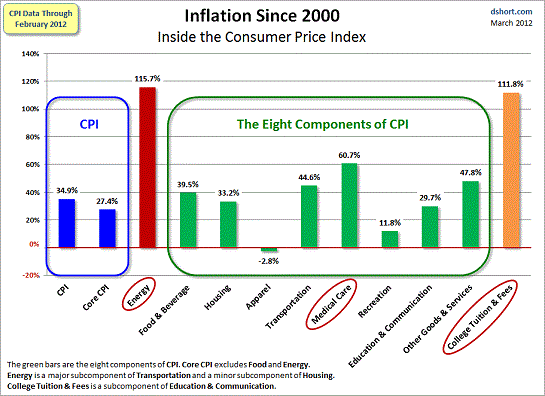
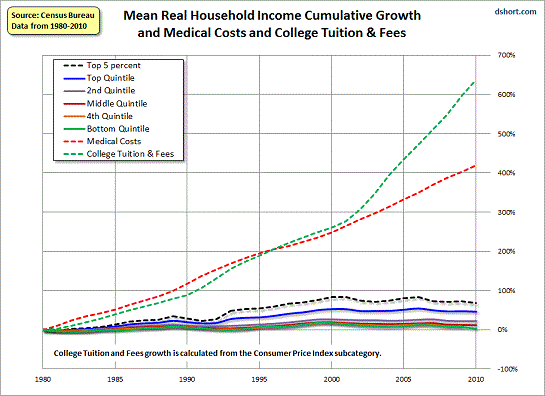
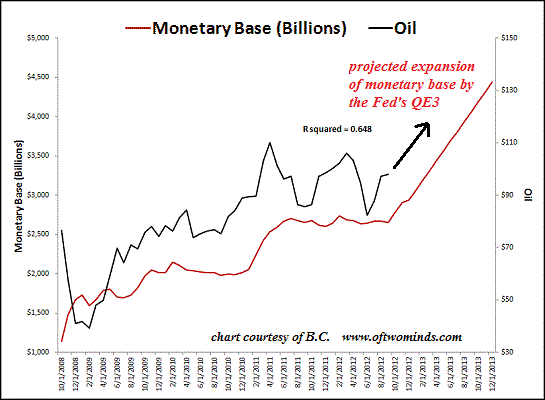
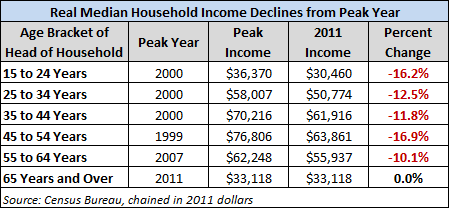
 Resistance, Revolution, Liberation: A Model for Positive Change (print $25)
Resistance, Revolution, Liberation: A Model for Positive Change (print $25)



















